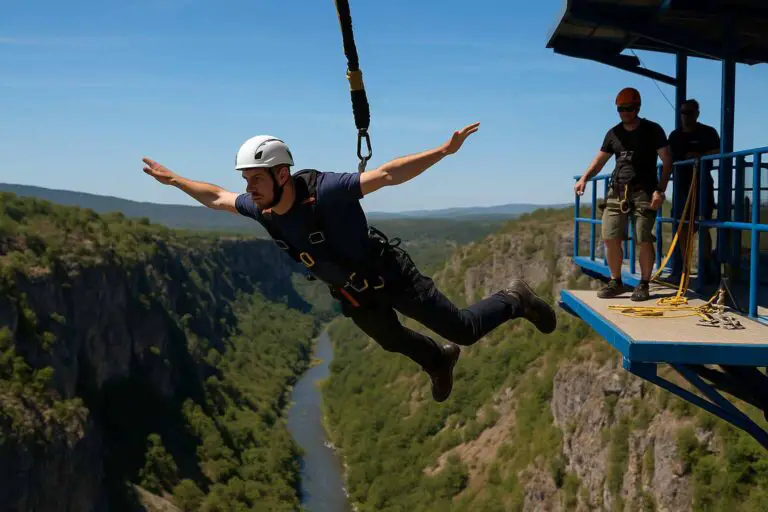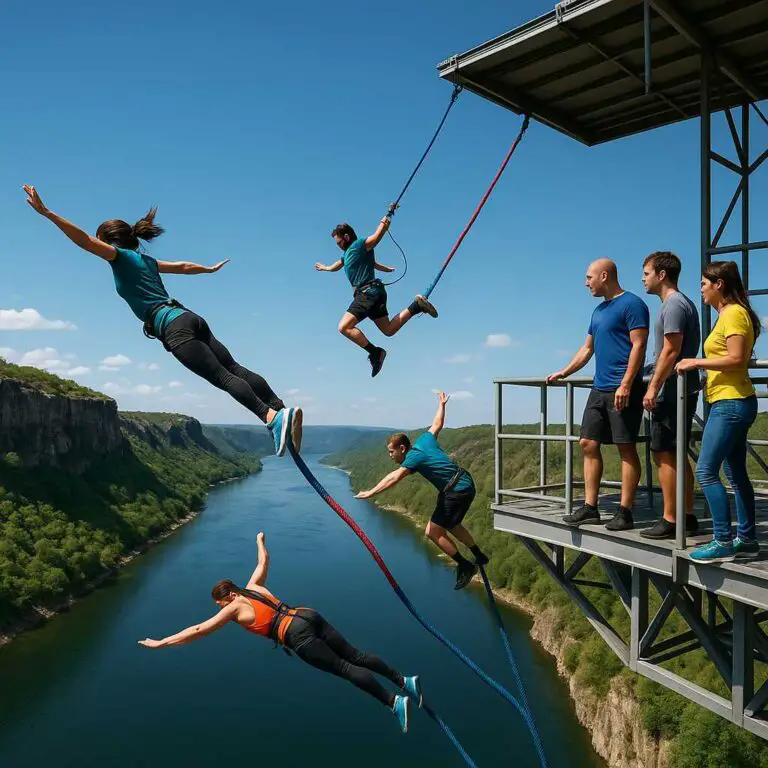Bungee jumping is an exhilarating and adrenaline-pumping adventure sport that has gained immense popularity over the years. People from all walks of life, seeking that heart-pounding thrill, have taken the plunge off bridges, cliffs, and even buildings. While bungee jumping is often associated with daring courage and precise equipment, one crucial factor that can influence the entire experience is often overlooked – the weather.
In this comprehensive guide, we will explore the significant role that weather conditions play in bungee jumping and how they can impact both safety and enjoyment.
Understanding the Basics of Bungee Jumping
Before diving into the weather’s influence on bungee jumping, let’s establish a basic understanding of the sport itself. Bungee jumping involves participants leaping from a tall structure with an elastic cord tied around their ankles. This cord, usually made of braided rubber, stretches to absorb the jump’s energy and then propels the jumper back upward, creating a thrilling bouncing effect.
Safety is paramount in bungee jumping, and all aspects of the jump are carefully regulated to minimize risks. The equipment used in bungee jumping, including the bungee cord, harnesses, and anchor points, must meet strict safety standards. Additionally, jump operators and instructors should be well-trained and experienced to ensure the safety of participants.
Now, let’s delve into how weather conditions can impact this thrilling activity.
The Influence of Weather on Bungee Jumping
Weather conditions can significantly affect the safety and overall experience of bungee jumping. While bungee jumping is possible in various weather conditions, certain weather elements need to be considered to ensure a safe and enjoyable jump. Here’s a detailed look at how different weather factors come into play:
1. Wind Speed and Direction
Wind is perhaps the most critical weather factor that can impact bungee jumping. High winds, especially gusty or turbulent winds, can pose a significant danger to jumpers. Strong winds can cause the jumper to swing erratically, potentially leading to collisions with the structure or other jumpers.
Wind direction also matters. The bungee cord must be anchored correctly to ensure a safe landing. If the wind is blowing in an unexpected direction, it can cause the jumper to miss the landing area, leading to an uncomfortable or even dangerous experience.
To mitigate the impact of wind, jump operators closely monitor wind speeds and directions. They may have wind limits in place, and jumps may be postponed or canceled if wind conditions exceed these limits. Safety should always take precedence over the thrill of the jump.
2. Temperature
While temperature might not seem as critical as wind, it can still affect the bungee jumping experience. Extremely cold temperatures can make the jump uncomfortable for participants, leading to numbness or frostbite in extreme cases. Conversely, very high temperatures can make jumpers feel uncomfortable in their harnesses and clothing.
Jump operators often provide guidelines on what to wear during jumps in different temperature ranges. It’s essential for participants to dress appropriately to ensure both comfort and safety during the experience.
3. Precipitation
Rain, snow, and other forms of precipitation can pose challenges to bungee jumping. Wet conditions can make the jump platform and surrounding areas slippery, increasing the risk of slips and falls. Additionally, precipitation can add extra weight to the bungee cord, affecting its elasticity and potentially leading to a less thrilling bounce.
Jump operators typically avoid conducting jumps during heavy rain, snowstorms, or icy conditions. However, light rain or drizzle may not always result in cancellations, as long as the safety of participants can be assured.
4. Cloud Cover and Visibility
Visibility is essential for bungee jumping, both for safety and the overall experience. Jumpers need to see where they are jumping and where they will land. Overcast or foggy conditions can reduce visibility, making it challenging for jumpers to orient themselves during the jump.
Low visibility can also impact the experience of taking in the breathtaking views from the jump site. Many bungee jumping locations are chosen for their scenic beauty, and poor visibility can diminish this aspect of the adventure.
5. Lightning and Thunderstorms
Perhaps the most dangerous weather condition for bungee jumping is lightning and thunderstorms. Lightning poses a direct and immediate threat to jumpers, as the metal components of the bungee setup can attract lightning strikes.
Jump operators take lightning and thunderstorms very seriously and will not conduct jumps when there is a risk of lightning. Safety protocols typically include suspending operations well before the onset of a storm and waiting until conditions are safe before resuming jumps.
How to Plan Your Bungee Jump Considering Weather
If you’re planning a bungee jump, it’s essential to consider the weather conditions at your chosen jump site. Here are some steps to help you plan your jump with weather in mind:
1. Check the Weather Forecast
Before making any arrangements, check the weather forecast for the date and location of your jump. Pay attention to wind speeds, precipitation, and any potential weather hazards like thunderstorms. If the forecast suggests unfavorable conditions, consider rescheduling your jump.
2. Contact the Jump Operator
Reach out to the jump operator or company to inquire about their weather policies and how they handle adverse weather conditions. Reputable operators will have safety protocols in place to ensure your well-being.
3. Be Flexible with Your Schedule
If you have the flexibility to choose your jump date, consider planning it during a season or time of year when the weather is more likely to be favorable. Avoid planning jumps during extreme weather conditions, such as the middle of winter or the peak of hurricane season.
4. Dress Appropriately
Prepare for the expected weather conditions by dressing appropriately. Wear layers to stay warm in cold weather and choose moisture-wicking clothing if there’s a chance of rain or snow. Follow the jump operator’s guidelines for clothing and attire.
5. Stay Informed
Stay informed about the weather conditions on the day of your jump. Weather can change quickly, so be prepared to adjust your plans if necessary. Trust the judgment of the jump operator if they decide to postpone or cancel the jump due to adverse weather conditions.
The Role of Weather in Different Types of Bungee Jumping
Bungee jumping can take place in various settings, each with its unique weather considerations. Here’s how weather factors can influence different types of bungee jumping:
1. Bridge Bungee Jumping
Bridge bungee jumping is one of the most popular forms of bungee jumping. Participants leap from bridges, often spanning deep canyons or rivers. Weather conditions on bridges can vary significantly, and the height of the bridge exposes jumpers to different wind patterns. It’s crucial for bridge bungee jump operators to closely monitor wind speeds and directions and make safety decisions accordingly.
2. Cliff Bungee Jumping
Cliff bungee jumping involves jumping from a high cliff or rocky outcrop. These locations are often exposed to the elements, making weather a more significant factor. Jumpers should be aware of potential changes in wind conditions as they ascend the cliff and take any necessary precautions.
3. Building Bungee Jumping
Building bungee jumping typically takes place from tall structures like skyscrapers or towers. In urban settings, wind can behave differently due to the surrounding buildings, creating unique challenges for jump operators. Wind speed and direction should be closely monitored, and jumps may be delayed or canceled if conditions are deemed unsafe.
The Impact of Altitude on Weather Conditions
Another factor to consider in bungee jumping is altitude. Many bungee jumping locations are at higher elevations, such as cliffs in mountainous regions or tall buildings in urban centers. Altitude can have a significant impact on weather conditions, including temperature and wind.
1. Temperature Variations
As you ascend to higher altitudes, the temperature tends to drop. This means that bungee jumpers at higher elevations may experience cooler conditions compared to those at lower altitudes. It’s important to dress accordingly and be prepared for temperature variations when jumping from high-altitude locations.
2. Wind Patterns
Altitude can also influence wind patterns. In mountainous areas, wind can be more unpredictable and turbulent due to the terrain’s unique features. Jump operators at high-altitude bungee jumping locations must have a deep understanding of local wind patterns and how they can impact jumps.
Tips for a Safe and Enjoyable Bungee Jump in Any Weather
Whether you’re planning a bungee jump from a bridge, cliff, or building, safety should always be your top priority. Here are some additional tips to ensure a safe and enjoyable bungee jumping experience in any weather:
1. Choose a Reputable Operator
Select a bungee jumping operator with a proven track record of safety and experience. Check reviews and testimonials to gauge the operator’s reputation. Safety measures and equipment quality are crucial factors in ensuring a safe jump.
2. Listen to the Instructors
Listen carefully to the instructions provided by the jump instructors. They will guide you on the correct jumping technique, body position, and safety protocols. Following their guidance is essential for a successful jump.
3. Know Your Health Limits
Bungee jumping can be physically demanding, so it’s important to be in reasonably good health. Discuss any pre-existing medical conditions with the jump operator and your doctor, and follow their advice regarding your suitability for the jump.
4. Stay Calm and Relaxed
Bungee jumping can be nerve-wracking, but try to stay calm and relaxed. Trust in the equipment and the expertise of the jump operators. Remember that bungee jumping is designed to be a thrilling and safe adventure.
5. Capture the Moment
Consider capturing your bungee jumping experience with photos or videos. Many jump operators offer professional photography or videography services to capture your jump. These mementos can help you relive the excitement and share your adventure with others.
Conclusion
Bungee jumping is an exhilarating adventure sport that offers a unique blend of adrenaline rush and breathtaking scenery. While weather conditions can impact the experience, with proper planning and safety measures in place, you can enjoy a safe and memorable bungee jump in a variety of weather conditions.
Remember to check the weather forecast, choose a reputable jump operator, and be prepared to adjust your plans if adverse weather arises. With the right precautions and a sense of adventure, you can take the leap and experience the thrill of bungee jumping while staying safe and enjoying every moment.








